Decision analysis: a formal prescriptive method
- Decisions that are "complex" in the effects they have
- Attempts to do better than ordinary decision making, by
the standards of utility maximization.
- Two types: probabilities and multiattribute
- These can be combined
Example of decision with probabilities:
amniocentesis
Here is an example for p(downs)=.00274. The example also assumes
that the abortion rate is higher than this (.00371) becasue of
false positive test results, but recent studies tend to assume a
false-positive rate very near zero.
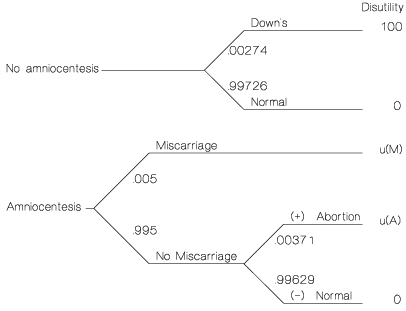
Calculation of relative EU of testing vs. not testing
The following form calculates the utility of testing vs. not testing using the
formula:
disutlity of no test - disutility of test, or
p(down)*u(down) - [p(miscarry)*u(miscarry) + p(abort)*u(abort)]
Assuming that p(abort) is the same as
p(down) (i.e., abortion if test is positive, no false
positives), this becomes:
p(down)*u(down) - [p(miscarry)*u(miscarry) + p(down)*u(abort)], or
p(down)*u(down) - p(miscarry)*u(miscarry) - p(down)*u(abort), or
p(down)*[u(down) - u(abort)] - p(miscarry)*u(miscarry)
Effects of age
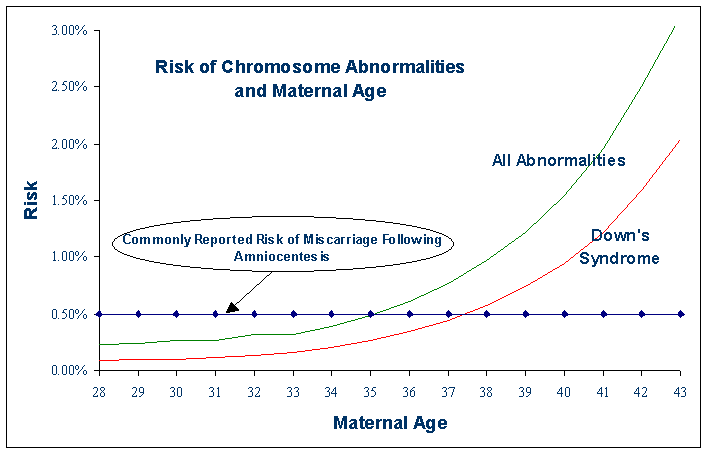
From N. Sicherman and A. Ferber
Why we need multi-attribute utility theory (MAUT)
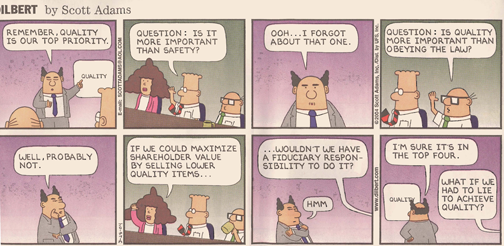
How to do MAUT
- Decide what the important aspects of the
decision are.
- Collect your options.
- Rank options on each dimension.
- Assign end point utility weights to best and
worst. Scale on this is arbitrary. We often use0 for
the worst, 100 for the best.
- Assign intermediate utilities for the rest.
- This can be done by direct judgment.
- This can also be done by any other method, such as standard
gambles or time tradeoff.
- Usually this is monotonic. When not?
- Assign weights to dimensions. Not all
dimensions are equally important. MOST CRITICAL
STEP.
Example: birth control
| HIV | STD | Hlth. | Preg. | Easy | Sex | TOTAL |
| prev. | prev. | risk | prev. | use | pleas. | UTIL. |
| IUD | 0 | 0 | 0 | 96 | 50 | 100 | 196.8 |
| Pill | 0 | 0 | 50 | 94 | 80 | 100 | 247.2 |
| Norplant | 0 | 0 | 0 | 99 | 100 | 100 | 219.2 |
| Condom | 99 | 99 | 90 | 84 | 0 | 90 | 377.7 |
| Diaphr. | 0 | 0 | 90 | 82 | 0 | 95 | 232.6 |
| None | 0 | 0 | 90 | 15 | 100 | 100 | 224.0 |
| Abstain | 100 | 100 | 100 | 100 | 100 | 0 | 350.0 |
| WEIGHT | 1.00 | .50 | .80 | .80 | .40 | 1.00 | |
For condom, the sum is 1.00 ·99 + .50 ·99 + .80
·90 + .80 ·84 + .40 ·0 + 1.00 ·90 = 377.7 .
Analysis of life (from Baron et al., 2001)
- Pain, fatigue, and discomfort: 0 = no effect; 100 = as bad as death.
- Economic standard of living: 0 = no effect; 100 = dire poverty.
- Work: 0 = no effect; 100 = unable to do any work.
- Love life: 0 = no effect; 100 = love life nonexistent.
- Family life: 0 = no effect; 100 = family life nonexistent.
- Spiritual life: 0 = no effect; 100 = spiritual life nonexistent.
- Leisure activities: 0 = no effect; 100 = activities nonexistent.
Please try to interpret these descriptions so that they do not
count the same effects twice. For example, if "spiritual life"
includes communing with nature, do not also count this as part of
"leisure".
Singer's analysis of life (roughly)
Experience
Ongoing plans, personhood
Attachments
(Desire for) potential
The idea of weight
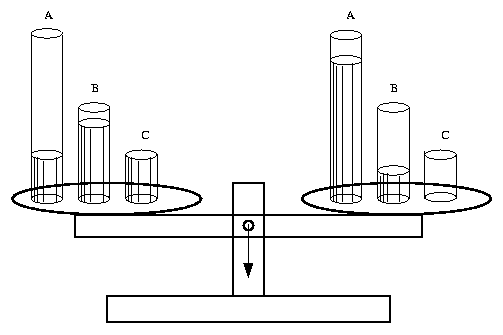
We can think of a decision as a balancing of two (or more)
options. Each option here has 3 attributes. Each attribute is
represented by a container that is full of a certian amount of
its type of utility (utility-on-attribute). The
utility-on-attribute numbers represent the percents full. The
weights represent the sizes of the containers.
How weight depends on range

| Attribute | A | B | C |
|---|
| Utility on attribute | 25 | 80 | 100 |
| Weight | 1.00 | 0.55 | 0.275 |
| Utility | 25 | 44 | 27.5 |
|
The table shows the numbers and
weights for the option on the left above. The weights are
relative to the first attribute.
The utility-on-attribute numbers are relative to the top and
bottom of each container. If the top goes up, then the utility
number assigned to the same level must go down, but the weight of
the attribute will go up. The weight thus depends on the range.
The range is the difference between the top and bottom.
For example, change attribute C's range.
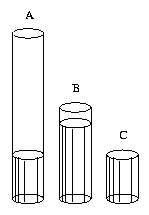 |
to |
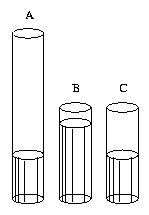 |
| Attribute | A | B | C |
|---|
| Utility on attribute | 25 | 80 |
100 |
| Weight | 1.00 | 0.55 |
0.275 |
| Utility | 25 | 44 |
27.5 | |
|
to |
| Attribute | A | B | C |
|---|
| Utility on attribute | 25 | 80 |
50 |
| Weight | 1.00 | 0.55 |
0.55 |
| Utility | 25 | 44 |
27.5 | |
|
The reference point for the attribute utility has changed. As
a result, the utility-on-attribute and the weight of C change,
but the final utility is the same.
The most important point here is that we cannot compare
weights without knowing the top and bottom of each range
(container).
Indifference curves (Von Winterfeldt and Edwards)
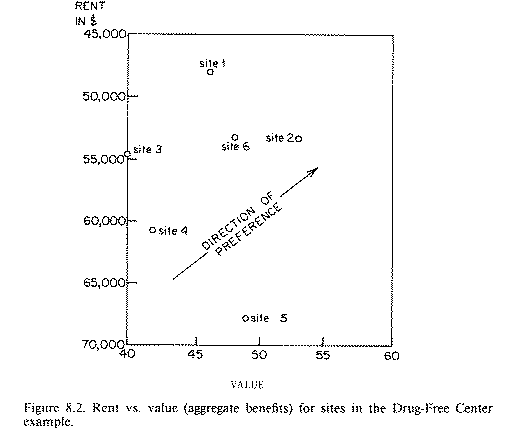
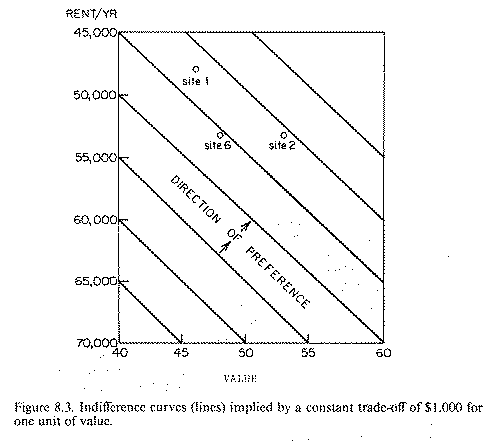
Using one attribute to measure another

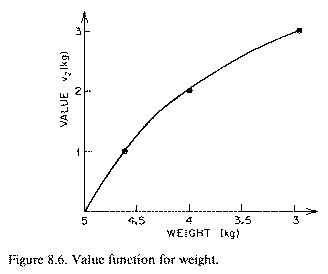
Consistency check: Thomson condition
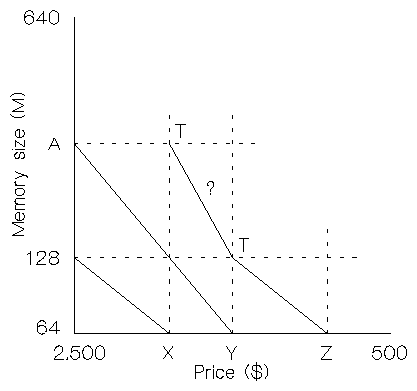 The point is that a certain change in one attribute - from X to
Y, or from Y to Z - has the same effect on utility, regardless of
the level of the other attribute(s). If the change bumps you up
to the next level (the next indifference curve), it will do this
no matter which curve you start on.
The point is that a certain change in one attribute - from X to
Y, or from Y to Z - has the same effect on utility, regardless of
the level of the other attribute(s). If the change bumps you up
to the next level (the next indifference curve), it will do this
no matter which curve you start on.
Independence in 3D
A simpler test involves three dimensions. The idea of
preferential independence is that the tradeoff of any two
dimensions does not depend on the level of any others. If a
change from X to Y is compensated by a change from 128 to 64 (as
it is), that fact remains true regardless of the levels of other
attributes.
The basic idea is that we can add utilities of attributes.
This is a psychological condition. It is about what you value.
It is not about correlations in the world. The space of
possibilities shown in these graphs need not exist. It might be
that only the two points labeled "T" exist, so that there is a
perfect correlation between price and memory. It doesn't matter,
because we can imagine the other points.
Example from Gardiner and Edwards
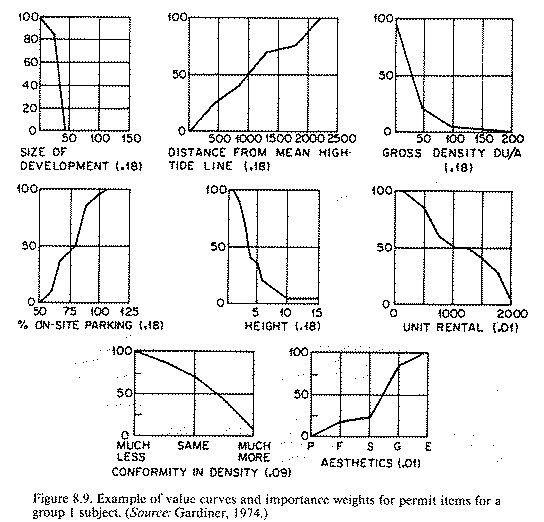
California coast (before)

California coast (after)


Effects of MAUT: Gardiner and Edwards
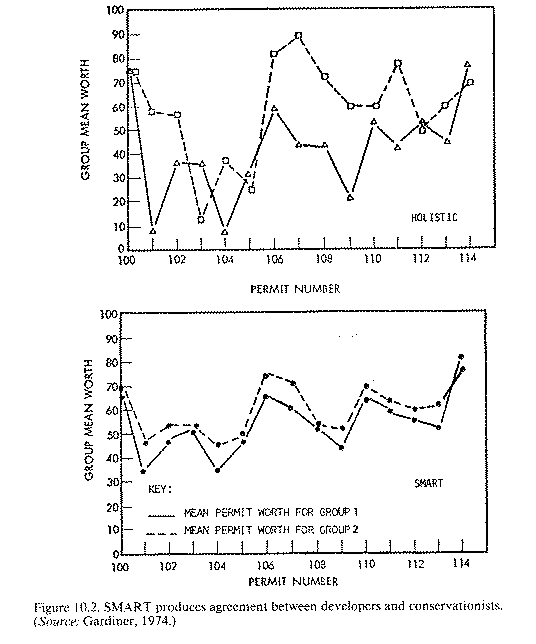
The main insight (Keeney)
5.4 Prioritizing Objectives
It is natural when thinking about objectives to think about their
relative importance. In evaluating possible employment offers,
you may naturally wish to maximize your salary and minimize your
commuting time. Which of these objectives is more important?
Suppose it is salary. Then is salary five times more important?
As we will see below, it is not possible to answer such questions
so that the response is unambiguous. When we quantify objectives
by simply asking for their relative importance, considerable
misinformation about values is produced and a substantial
opportunity to understand values is lost.
The importance of an objective must depend on how much
achievement of that objective we are talking about. Clearly a
cost of $200 million is more important than a cost of $4 million.
So if somebody asks whether the environmental risk at a hazardous
waste site is more important than the cleanup cost, it should
make a difference whether the cost is $4 million or $200 million.
Let us examine this in more detail and then discuss how objectives
should be prioritized.
The Most Common Critical Mistake
There is one mistake that is very commonly made in prioritizing
objectives. Unfortunately, this mistake is sometimes the basis
for poor decisionmaking. It is always a basis for poor
information. As an illustration, consider an air pollution
problem where the concerns are air pollution concentrations and
the costs of regulating air pollution emissions. Administrators,
regulators, and members of the public are asked questions such as
"In this air pollution problem, which is more important, costs or
pollutant concentrations?" Almost anyone will answer such a
question. They will even answer when asked how much more important
the stated "more important" objective is.
For instance, a respondent might state that pollutant
concentrations are three times as important as costs. While the
sentiment of this statement may make sense, it is completely
useless for understanding values 148 or for building a model of
values. Does it mean, for example, that lowering pollutant
concentrations in a metropolitan area by one part per billion
would be worth the cost of $2 billion? The likely answer is "of
course not." Indeed, this answer would probably come from the
respondent who had just stated that pollutant concentrations
were three times as important as costs. When asked to clarify the
apparent discrepancy, he or she would naturally state that the
decrease in air pollution was very small, only one part in a
billion, and the cost was a very large $2 billion. The point
should now be clear. It is necessary to know how much the change
in air pollution concentrations will be and how much the costs of
regulation will be in order to logically discuss and quantify the
relative importance of the two objectives.
This error is significant for two reasons. First, it doesn't
really afford the in-depth appraisal of values that should be
done in important decision situations. If we are talking about
the effects on public health of pollutant concentrations and
billion-dollar expenditures, I personally don't want some
administrator to give two minutes of thought to the matter and
state that pollutant concentrations are three times as important
as costs. Second, such judgments are often elicited from the
public, concerned groups, or legislators. Then decisionmakers use
these indications of relative importance in inappropriate ways.
The Clean Air Act of the United States provides an illustrative
example. This law essentially says that the health of the public
is of paramount importance and that costs of achieving air
pollutant levels should not be considered in setting standards
for those levels. Of course, this is not practical or possible or
desirable in the real world. After spending hundreds of billions
of dollars, we could still improve our air quality further with
additional expenditures. This would be the case even if we could
only further improve the "national health" by reducing by five
the annual number of asthma attacks in the country. If the value
tradeoffs are done properly and address the question of how much
of one specific attribute is worth how much of another specific
attribute, the insights from the analysis are greatly increased
and the likelihood of misuse of those judgments is greatly
decreased.










 The point is that a certain change in one attribute - from X to
Y, or from Y to Z - has the same effect on utility, regardless of
the level of the other attribute(s). If the change bumps you up
to the next level (the next indifference curve), it will do this
no matter which curve you start on.
The point is that a certain change in one attribute - from X to
Y, or from Y to Z - has the same effect on utility, regardless of
the level of the other attribute(s). If the change bumps you up
to the next level (the next indifference curve), it will do this
no matter which curve you start on.




